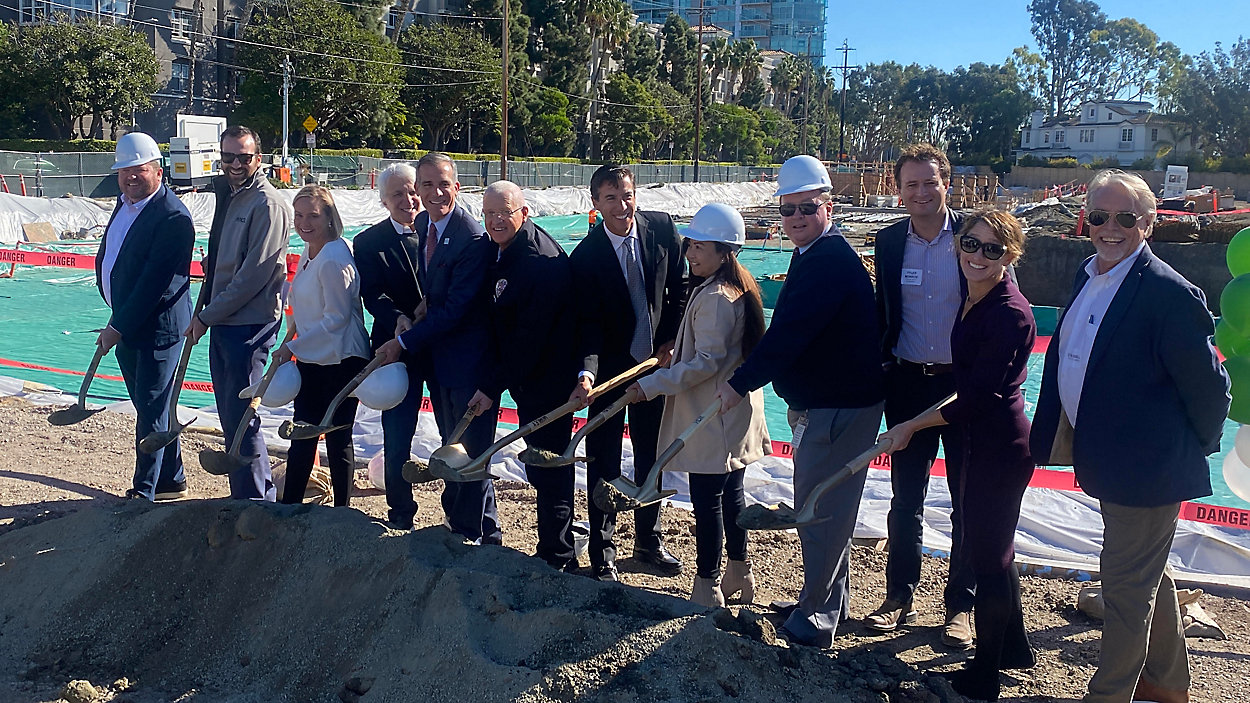On a gray December morning in 2022, weeks after voters in Los Angeles elected a new city council, shovels struck the dirt at Thatcher Yard. The long-planned redevelopment of a municipal maintenance yard into affordable housing was finally underway. For supporters who shepherded the project for years, the timing was deliberate. The groundbreaking happened between the election and the swearing-in of incoming Councilmember Traci Park, ensuring that construction would be irreversible before she entered office.
Despite her reputation as a vocal opponent of affordable housing, Park has sought to present Thatcher Yard as a signature accomplishment, praising the development as the kind of project the city needs more of. At its grand opening this August, she offered effusive thanks to the developer, Thomas Safran, noting the “more than 50 meetings” his team held with neighbors and describing the building as a model of housing done right. The clear subtext of her remarks was that Thatcher Yard represents the right way to build, while Venice Dell, the affordable housing development she has spent her tenure trying to kill, represents the wrong way.
The history tells a different story. Thatcher Yard was conceived years before Park entered office. In 2016, then-Councilmember Mike Bonin identified it as one of several city-owned sites that could be converted to affordable and supportive housing. Early plans envisioned 160 units in a five-story structure, but neighbors in the Oxford Triangle objected, raising alarms about height, density, traffic, and parking. Developer Thomas Safran negotiated with them, ultimately cutting the project down to 98 units in a mix of two- and three-story buildings, adding parking, and lowering the profile next to single-family homes. Bonin’s office committed to a full public process, and with each round of adjustments the intensity of opposition diminished. By the time construction began, many of the loudest voices had accepted the outcome. The groundbreaking on December 8, 2022 signaled that the project was a fait accompli. Park, still only councilmember-elect, was present for the photo opportunity but had no role in delivering it.
Venice Dell, by contrast, endured a much longer and more bruising process. Like Thatcher Yard, it was identified in the 2016 surplus land survey and subjected to years of hearings, environmental studies, and design revisions. But because of its location along the Venice Canals, it also required Coastal Commission approval, which stretched out the timeline and exposed the project to a newly hostile neighborhood council and an organized base of wealthy homeowners determined to stop it. Nonprofit developers Venice Community Housing and Hollywood Community Housing reduced its scale from 140 to 120 units, reconfigured its layout, preserved a boat launch, and added parking.
The project twice won City Council approval and twice prevailed in court. Yet the opposition never relented, in part because Venice Dell was designed with a large share of units for people exiting homelessness, a population that Canal-area homeowners fought aggressively to keep out. By contrast, Thatcher Yard was built for seniors and low income families, with half the units allocated to formerly unhoused residents. When Park ran for council, she capitalized on that resistance, pledging to block the project and writing to city leaders on her campaign letterhead to demand a halt until she took office. Once elected, she and the new City Attorney Hydee Feldstein-Soto began refusing routine permits and agreements, stranding a project that had already cleared every official hurdle. In 2024, housing advocates sued, naming Park directly for using her office to obstruct Venice Dell.
Park is now using Thatcher Yard as a cudgel against Venice Dell, implying that the latter was pushed through without adequate community input. That narrative is false. Venice Dell had as many or more public meetings than Thatcher Yard, its developers made extensive revisions in response to feedback, and the project won City Council approval twice. The difference is not process but politics. Bonin was willing to absorb the heat and push Thatcher Yard through, but Park aligned herself with opponents and used her power to stall Venice Dell, despite its entitlements.
The irony is that Thatcher Yard succeeded largely because construction was already underway when Park entered office. People close to the process note that if the project had still been uncertain, she likely would have opposed it just as she did Venice Dell. Instead, she now embraces it as her own, part of a larger pattern in which she blocks housing when she can and takes credit once it becomes irreversible.

